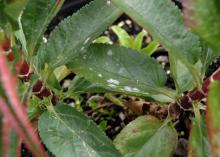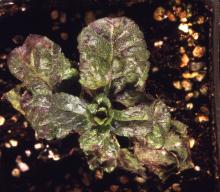Cause Sphaerotheca sp. has been reported in Oregon and found a few times by the OSU Plant Clinic. This is a highly specialized pathogen that form a close association with the host. Conditions that favor the host also tend to favor the pathogen. The disease is favored by low light, warm conditions (60°F to 80°F) and cool nights. Overcrowding of plants is also favorable for disease development.
Symptoms White patches on leaves. On some cultivars purplish patches are seen on the upper side of leaves.
Cultural control
- Space plants for good air circulation.
- Remove and destroy infected plants.
- There are differences in cultivar reaction so select ones that are more resistant.
Chemical control Use before symptoms develop. Alternate or tank-mix products from different groups that have different modes of action. Although not many fungicides are registered for this crop, there may be several others that are effective and legal to use. Try on a few plants first to test for phytotoxicity before wide scale use.
- Compass 50 WDG at 1 to 2 oz/100 gal water. Do not use organosilicate additives. Group 11 fungicide. 12-hr reentry.
- Eagle 20 EW at 6 to 12 fl oz/100 gal water. Group 3 fungicide. 24-hr reentry.
- Heritage at 1 to 4 oz/100 gal water plus a non-silicone-based wetter sticker. Group 11 fungicide. 4-hr reentry.
- Pageant at 6 to 12 oz/100 gal water. Do not use with organosilicone-based adjuvants. Group 7 + 11 fungicide. 12-hr reentry.
- Phyton 27 at 1 to 2 fl oz/10 gal water. Group M1 fungicide. 48-hr reentry.
- Seido at 4 to 5 fl oz/100 gal water plus an adjuvant. Group 50 fungicide. 4-hr reentry.
Reference Gleason, M.L., Daughtrey, M.L., Chase, A.R., Moorman, G.W., and Mueller, D.S. 2009. Diseases of Herbaceous Perennials. APS Press, St. Paul, MN.


